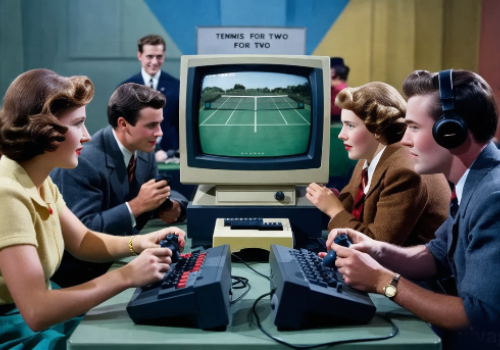BLOG
.jpg)
The Inception of Computer Gaming

The 1950s and 1960s: The Birth of Gaming
The history of computer gaming dates back to the 1950s, with early experiments like Tennis for Two and OXO. These games were primarily developed for research purposes, showcasing the potential of computers as entertainment devices. By the 1970s, the gaming landscape began to shift with the creation of arcade games like Pong, which marked the transition from research-based projects to mainstream entertainment.
The 1980s: Home Consoles and the Rise of Game Design
The 1980s saw the rise of home gaming consoles, such as the Atari 2600 and the Nintendo Entertainment System (NES). These systems brought gaming into the living rooms of millions of people. Iconic franchises like Super Mario Bros. and The Legend of Zelda not only laid the foundation for the gaming culture we know today but also created a demand for skilled professionals in game design and VFX.


The 1990s: Technological Advancements and the Internet
In the 1990s, gaming technology advanced rapidly with the introduction of 3D graphics, immersive environments, and the rise of personal computers. The decade also saw the birth of online gaming, with titles like Ultima Online and EverQuest creating real-time virtual worlds. This period underscored the growing importance of game design courses, where students could learn to develop increasingly complex games and immersive visual effects.
The Online Gaming Boom
The 2000s: MMOs and the Expansion of Career Opportunities
With the early 2000s came the rise of Massively Multiplayer Online (MMO) games, such as World of Warcraft and Guild Wars, which attracted millions of players globally. These games required skilled professionals in design, programming, and VFX to create engaging online environments. The growth of online gaming also fueled the need for AR/VR design courses, as game developers began to explore more immersive experiences.


The 2010s: The Rise of Mobile Gaming and Streaming
Mobile gaming became a dominant force in the 2010s, with titles like Candy Crush Saga and Clash of Clans achieving widespread popularity. Additionally, platforms like Twitch and YouTube Gaming revolutionized the gaming industry by transforming it into a spectator sport. The growing popularity of mobile games and streaming platforms also highlighted the demand for skilled VFX and AR/VR designers, as these professionals play a crucial role in creating visually stunning, immersive content.

The Present Demand for Gaming and Design Careers
The Gaming Market Today Today, the gaming industry is a multi-billion-dollar entertainment sector, surpassing the film and music industries in revenue. As the industry continues to grow, the demand for skilled professionals in VFX, AR/VR, and game design has skyrocketed. Colleges in Nagpur and other design institutions are responding to this demand by offering specialized courses that equip students with the skills needed to succeed in the gaming world.
Trends Driving Career Opportunities Several trends are shaping the future of the gaming industry and design careers:
1. Esports: The rise of competitive gaming has created new job opportunities in event management, broadcasting, and marketing.
2.Virtual Reality (VR) and Augmented Reality (AR): These technologies are transforming gaming experiences, making AR/VR design a sought-after skill in the industry.
3.Diversity and Inclusion: Game developers are increasingly focused on creating diverse narratives and characters, opening up opportunities for designers to bring fresh perspectives to the industry.
VFX, AR/VR Design, and Game Design Courses: The Key to Success
The Importance of Design Education As the gaming industry continues to expand, there is a growing need for skilled professionals with expertise in VFX design, AR/VR, and game development. Colleges in Nagpur and other institutions around the world are offering design courses that cover essential topics, such as:
1.VFX and Game Art: Students learn to create stunning visual effects that enhance gaming environments.
2.AR/VR Design: This specialization focuses on developing immersive virtual experiences for gaming and beyond
3. Game Mechanics and Design Principles: Understanding what makes a game engaging and interactive is crucial for aspiring game designers.

Internships and Industry Connections
Many design colleges, including those in Nagpur, emphasize the importance of practical experience. Internships with gaming companies allow students to gain hands-on experience and build valuable industry connections. These programs are vital for launching successful careers in design, especially in competitive fields like VFX and AR/VR.
Conclusion
The gaming industry has come a long way from its humble beginnings, evolving into a global entertainment phenomenon. With the continued rise of esports, AR/VR, and mobile gaming, the demand for skilled professionals in VFX, game design, and AR/VR is greater than ever. Design courses offered by colleges in Nagpur and beyond are instrumental in preparing the next generation of creators, ensuring that the future of gaming remains bright. Whether you're interested in a career in VFX, AR/VR design, or game development, the opportunities in the gaming industry are vast and ever-growing.








.webp)
